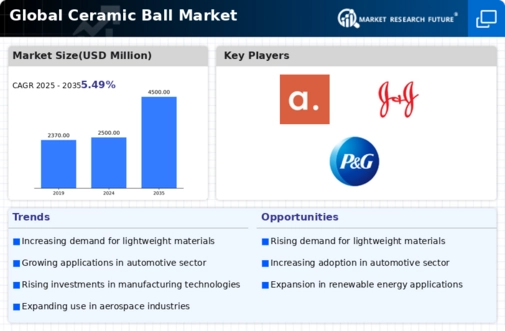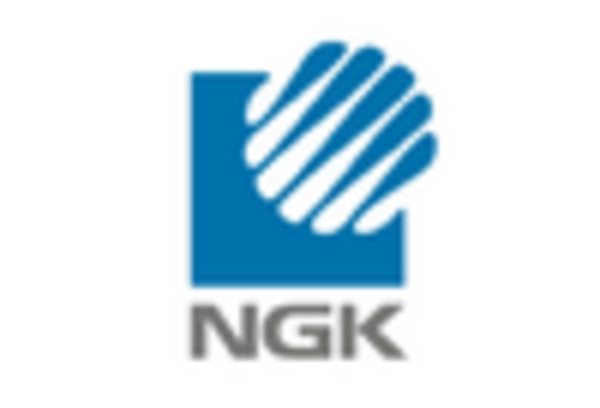-
Executive Summary
-
Market Introduction
-
Market
-
Definition
-
Scope of the Study
-
List of Assumptions
-
Markets Structure
-
Market Research Methodology
-
Research Process
-
Primary Research
-
Secondary Research
-
Market Size Estimation
-
Forecast Model
-
Market Dynamics of Global Ceramic Ball Market
-
Introduction
-
Drivers
-
Restraints
-
Opportunities
-
Challenges
-
Trends/Technology
-
Market Factor Analysis of Global Ceramic Ball Market
-
Supply
- Raw Material Type Suppliers
- Manufacturers/Producers
- Distributors/Retailers/Wholesalers/E-Commerce
- End Users
-
Chain Analysis
-
Porter’s
- Threat of New Entrants
- Bargaining Power of Buyers
- Bargaining Power of Suppliers
- Threat of Substitutes
-
Five Forces Analysis
-
Intensity of Competitive Rivalry
-
Pricing Analysis
-
Global Ceramic Ball Market,
-
by Material Type
-
Introduction
-
Alumina Oxide
- Market Estimates & Forecast,
- Market Estimates & Forecast, by Region, 2019−2027
- Market Estimates & Forecast, 2019−2027
- Market
-
Zirconia
-
Estimates & Forecast, by Region, 2019−2027
-
Ruby Sapphire
- Market
- Market Estimates & Forecast,
-
Estimates & Forecast, 2019−2027
-
by Region, 2019−2027
-
Silicon Nitride
- Market Estimates & Forecast,
- Market Estimates & Forecast, by Region, 2019−2027
- Market Estimates & Forecast, 2019−2027
- Market
-
Others
-
Estimates & Forecast, by Region, 2019−2027
-
Global Ceramic Ball Market,
-
by Application
-
Introduction
-
Bearings
- Market Estimates & Forecast,
- Market Estimates & Forecast, by Region, 2019−2027
- Market Estimates & Forecast, 2019−2027
- Market
-
Valves
-
Estimates & Forecast, by Region, 2019−2027
-
Ball Screws
- Market
- Market Estimates & Forecast,
-
Estimates & Forecast, 2019−2027
-
by Region, 2019−2027
-
Grinding
- Market Estimates & Forecast,
- Market Estimates & Forecast, by Region, 2019−2027
- Market Estimates & Forecast, 2019−2027
-
Chemical Pumps
-
Market Estimates & Forecast, by Region, 2019−2027
-
Flowmeter
- Market
- Market Estimates & Forecast,
-
Estimates & Forecast, 2019−2027
-
by Region, 2019−2027
-
Others
- Market Estimates & Forecast,
- Market Estimates & Forecast, by Region, 2019−2027
-
Global Ceramic Ball Market, by End-Use Industry
-
Introduction
-
Aerospace
- Market Estimates & Forecast, 2019−2027
- Market
-
Estimates & Forecast, by Region, 2019−2027
-
Automotive
- Market
- Market Estimates & Forecast,
-
Estimates & Forecast, 2019−2027
-
by Region, 2019−2027
-
Chemical
- Market Estimates & Forecast,
- Market Estimates & Forecast, by Region, 2019−2027
- Market Estimates & Forecast, 2019−2027
- Market
-
Others
-
Estimates & Forecast, by Region, 2019−2027
-
Global Ceramic Ball Market,
-
by Region
-
Introduction
-
North America
- Market Estimates & Forecast,
- Market Estimates & Forecast, by Material Type, 2019−2027
-
Market Estimates & Forecast, by Application, 2019−2027
-
Estimates & Forecast, by End-Use Industry, 2019−2027
-
Market Estimates & Forecast, 2019−2027
-
Forecast, by Material Type, 2019−2027
-
Forecast, by Application, 2019−2027
-
Forecast, by End-Use Industry, 2019−2027
-
Estimates & Forecast, 2019−2027
-
Forecast, by Material Type, 2019−2027
-
Forecast, by Application, 2019−2027
-
Forecast, by End-Use Industry, 2019−2027
-
Market
-
US
-
Market Estimates &
-
Market Estimates &
-
Market Estimates &
-
Canada
-
Market
-
Market Estimates &
-
Market Estimates &
-
Market Estimates &
-
Europe
- Market Estimates & Forecast,
- Market Estimates & Forecast, by Material Type, 2019−2027
-
Market Estimates & Forecast, by Application, 2019−2027
-
Estimates & Forecast, by End-Use Industry, 2019−2027
-
Market Estimates & Forecast, 2019−2027
-
Forecast, by Material Type, 2019−2027
-
Forecast, by Application, 2019−2027
-
Forecast, by End-Use Industry, 2019−2027
-
Estimates & Forecast, 2019−2027
-
Forecast, by Material Type, 2019−2027
-
Forecast, by Application, 2019−2027
-
Forecast, by End-Use Industry, 2019−2027
-
Estimates & Forecast, 2019−2027
-
Forecast, by Material Type, 2019−2027
-
Forecast, by Application, 2019−2027
-
Forecast, by End-Use Industry, 2019−2027
-
Estimates & Forecast, 2019−2027
-
Forecast, by Material Type, 2019−2027
-
Forecast, by Application, 2019−2027
-
Forecast, by End-Use Industry, 2019−2027
-
Forecast, 2019−2027
-
Type, 2019−2027
-
Market
-
Germany
-
Market Estimates &
-
Market Estimates &
-
Market Estimates &
-
France
-
Market
-
Market Estimates &
-
Market Estimates &
-
Market Estimates &
-
Italy
-
Market
-
Market Estimates &
-
Market Estimates &
-
Market Estimates &
-
Spain
-
Market
-
Market Estimates &
-
Market Estimates &
-
Market Estimates &
-
UK
-
Market Estimates &
-
Market Estimates & Forecast, by Material
-
Market Estimates & Forecast, by Application, 2019−2027
-
Market Estimates & Forecast, by End-Use Industry, 2019−2027
-
Russia
-
Estimates & Forecast, by Material Type, 2019−2027
-
Forecast, by Application, 2019−2027
-
Forecast, by End-Use Industry, 2019−2027
-
Estimates & Forecast, 2019−2027
-
Forecast, by Material Type, 2019−2027
-
Forecast, by Application, 2019−2027
-
Forecast, by End-Use Industry, 2019−2027
-
Market Estimates & Forecast, 2019−2027
-
Forecast, by Material Type, 2019−2027
-
Forecast, by Application, 2019−2027
-
Forecast, by End-Use Industry, 2019−2027
-
Estimates & Forecast, 2019−2027
-
by Material Type, 2019−2027
-
Market Estimates & Forecast, 2019−2027
-
Market
-
Market Estimates &
-
Market Estimates &
-
Poland
-
Market
-
Market Estimates &
-
Market Estimates &
-
Market Estimates &
-
Rest of Europe
-
Market Estimates &
-
Market Estimates &
-
Market Estimates &
-
Asia-Pacific
- Market
- Market Estimates & Forecast,
- Market Estimates & Forecast, by Application,
- Market Estimates & Forecast, by End-Use Industry,
- China
-
Market Estimates & Forecast, by Material Type, 2019−2027
-
Estimates & Forecast, by Application, 2019−2027
-
Forecast, by End-Use Industry, 2019−2027
-
Estimates & Forecast, 2019−2027
-
Forecast, by Material Type, 2019−2027
-
Forecast, by Application, 2019−2027
-
Forecast, by End-Use Industry, 2019−2027
-
Estimates & Forecast, 2019−2027
-
Forecast, by Material Type, 2019−2027
-
Forecast, by Application, 2019−2027
-
Forecast, by End-Use Industry, 2019−2027
-
Market Estimates & Forecast, 2019−2027
-
Forecast, by Material Type, 2019−2027
-
Forecast, by Application, 2019−2027
-
Forecast, by End-Use Industry, 2019−2027
-
Market Estimates & Forecast, 2019−2027
-
Forecast, by Material Type, 2019−2027
-
Forecast, by Application, 2019−2027
-
Forecast, by End-Use Industry, 2019−2027
-
Market Estimates & Forecast, 2019−2027
-
by Material Type, 2019−2027
-
Market
-
Market Estimates &
-
India
-
Market
-
Market Estimates &
-
Market Estimates &
-
Market Estimates &
-
Japan
-
Market
-
Market Estimates &
-
Market Estimates &
-
Market Estimates &
-
Australia & New Zealand
-
Market Estimates &
-
Market Estimates &
-
Market Estimates &
-
Rest of Asia Pacific
-
Market Estimates &
-
Market Estimates &
-
Market Estimates &
-
Middle East & Africa
- Market Estimates & Forecast,
- Market Estimates & Forecast, by Application,
- Market Estimates & Forecast, by End-Use Industry,
- GCC
-
Market Estimates & Forecast, by Material Type, 2019−2027
-
Estimates & Forecast, by Application, 2019−2027
-
Forecast, by End-Use Industry, 2019−2027
-
Estimates & Forecast, 2019−2027
-
Forecast, by Material Type, 2019−2027
-
Forecast, by Application, 2019−2027
-
Forecast, by End-Use Industry, 2019−2027
-
Market Estimates & Forecast, 2019−2027
-
Forecast, by Material Type, 2019−2027
-
Forecast, by Application, 2019−2027
-
Forecast, by End-Use Industry, 2019−2027
-
Estimates & Forecast, 2019−2027
-
Forecast, by Material Type, 2019−2027
-
Forecast, by Application, 2019−2027
-
Forecast, by End-Use Industry, 2019−2027
-
Africa
-
Estimates & Forecast, by Material Type, 2019−2027
-
Forecast, by Application, 2019−2027
-
Forecast, by End-Use Industry, 2019−2027
-
Estimates & Forecast, 2019−2027
-
by Material Type, 2019−2027
-
Market
-
Market Estimates &
-
Israel
-
Market
-
Market Estimates &
-
Market Estimates &
-
Market Estimates &
-
North Africa
-
Market Estimates &
-
Market Estimates &
-
Market Estimates &
-
Turkey
-
Market
-
Market Estimates &
-
Market Estimates &
-
Market Estimates &
-
Rest of Middle East &
-
Market Estimates & Forecast, 2019−2027
-
Market
-
Market Estimates &
-
Market Estimates &
-
Latin America
- Market
- Market Estimates & Forecast,
- Market Estimates & Forecast, by Application,
- Market Estimates & Forecast, by End-Use Industry,
- Brazil
-
Market Estimates & Forecast, by Material Type, 2019−2027
-
Estimates & Forecast, by Application, 2019−2027
-
Forecast, by End-Use Industry, 2019−2027
-
Estimates & Forecast, 2019−2027
-
Forecast, by Material Type, 2019−2027
-
Forecast, by Application, 2019−2027
-
Forecast, by End-Use Industry, 2019−2027
-
Estimates & Forecast, 2019−2027
-
Forecast, by Material Type, 2019−2027
-
Forecast, by Application, 2019−2027
-
Forecast, by End-Use Industry, 2019−2027
-
Market Estimates & Forecast, 2019−2027
-
Forecast, by Material Type, 2019−2027
-
Forecast, by Application, 2019−2027
-
Forecast, by End-Use Industry, 2019−2027
-
Market
-
Market Estimates &
-
Mexico
-
Market
-
Market Estimates &
-
Market Estimates &
-
Market Estimates &
-
Argentina
-
Market
-
Market Estimates &
-
Market Estimates &
-
Market Estimates &
-
Rest of Latin America
-
Market Estimates &
-
Market Estimates &
-
Market Estimates &
-
Company Landscape
-
Introduction
-
Market Strategy
-
Key Development Analysis (Expansion/Merger
-
& Acquisition/Joint Venture/New Product Development/Agreement/Investment)
-
Company Profiles
-
Industrial Tectonics Inc
- Company Overview
- Product Segment Overview
- Strategy
- Key
- SWOT Analysis
-
Financial Updates
-
Developments
-
Axens
- Company Overview
- Product Segment Overview
- Strategy
- Key
- SWOT Analysis
-
Financial Updates
-
Developments
-
Honeywell International Inc.
- Financial Updates
- Product Segment Overview
- Strategy
- Key Developments
- SWOT Analysis
- Company Overview
- Financial Updates
- Strategy
- Key Developments
-
Company Overview
-
Saint-Gobain
-
Product Segment Overview
-
SWOT Analysis
-
TOSHIBA MATERIALS CO., LTD
- Company Overview
- Product Segment Overview
- Strategy
- Key
- SWOT Analysis
-
Financial Updates
-
Developments
-
GLOBAL PRECISION BALL AND ROLLER
- Company Overview
- Financial Updates
- Product Segment Overview
- Strategy
- Key Developments
- SWOT Analysis
- Company Overview
- Financial Updates
- Strategy
- Key Developments
-
FineWay Inc
-
Product Segment Overview
-
SWOT Analysis
-
CoorsTek Inc
- Company Overview
- Financial
- Product Segment Overview
- Strategy
- Key
- SWOT Analysis
-
Updates
-
Developments
-
Devson Catalyst
- Company
- Financial Updates
- Product Segment Overview
- Key Developments
- SWOT Analysis
-
Overview
-
Strategy
-
MetalBall
- Company
- Financial Updates
- Product Segment Overview
- Key Developments
- SWOT Analysis
-
Overview
-
Strategy
-
Others
-
Appendix
-
-
LIST
-
OF TABLES
-
Global Ceramic Ball Market, by Region, 2019−2027
-
Table
-
North America: Ceramic Ball Market, by Country, 2019−2027
-
Europe:
-
Ceramic Ball Market, by Country, 2019−2027
-
Asia-Pacific: Ceramic
-
Ball Market, by Country, 2019−2027
-
Middle East & Africa:
-
Ceramic Ball Market, by Country, 2019−2027
-
Latin America: Ceramic
-
Ball Market, by Country, 2019−2027
-
Global Ceramic Ball Material
-
Type Market, by Regions, 2019−2027
-
North America: Ceramic
-
Ball Material Type Market, by Country, 2019−2027
-
Europe: Ceramic Ball Material
-
Type Market, by Country, 2019−2027
-
Table10 Asia-Pacific: Ceramic
-
Ball Material Type Market, by Country, 2019−2027
-
Table11 Middle East & Africa:
-
Ceramic Ball Material Type Market, by Country, 2019−2027
-
Table12 Latin
-
America: Ceramic Ball Material Type Market, by Country, 2019−2027
-
Table13
-
Global Ceramic Ball Application Market, by Regions, 2019−2027
-
Table14 North
-
America: Ceramic Ball by Application Market, by Country, 2019−2027
-
Table15
-
Europe: Ceramic Ball Application Market, by Country, 2019−2027
-
Table16
-
Asia-Pacific: Ceramic Ball Application Market, by Country, 2019−2027
-
Table17
-
Middle East & Africa: Ceramic Ball Application Market, by Country, 2019−2027
-
Table18 Latin America: Ceramic Ball Application Market, by Country, 2019−2027
-
Table19 Global Ceramic Ball End-Use Industry Market, by Regions, 2019−2027
-
Table20
-
North America: Ceramic Ball End-Use Industry Market, by Country, 2019−2027
-
Table21 Europe: Ceramic Ball End-Use Industry Market, by Country, 2019−2027
-
Table22 Asia-Pacific: Ceramic Ball End-Use Industry Market, by Country,
-
Table23 Middle East & Africa: Ceramic Ball End-Use Industry
-
Market, by Country, 2019−2027
-
Table24 Latin America: Ceramic Ball End-Use
-
Industry Market, by Country, 2019−2027
-
Table25 Global Material Type Market,
-
by Region, 2019−2027
-
Table26 Global Application Market, by Region, 2019−2027
-
Table27 Global End-Use Industry Market, by Region, 2019−2027
-
Table28
-
North America: Ceramic Ball Market, by Country
-
Table29 North America: Ceramic
-
Ball Market, by Material Type
-
Table30 North America: Ceramic Ball Market, by Application
-
Table31 North America: Ceramic Ball Market, by End-Use Industry
-
Table32
-
Europe: Ceramic Ball Market, by Country
-
Table33 Europe: Ceramic Ball Market,
-
by Material Type
-
Table34 Europe: Ceramic Ball Market, by Application
-
Table35
-
Europe: Ceramic Ball Market, by End-Use Industry
-
Table36 Asia-Pacific: Ceramic
-
Ball Market, by Country
-
Table37 Asia-Pacific: Ceramic Ball Market, by Material
-
Type
-
Table38 Asia-Pacific: Ceramic Ball Market, by Application
-
Table39 Asia-Pacific:
-
Ceramic Ball Market, by End-Use Industry
-
Table40 Middle East & Africa: Ceramic
-
Ball Market, by Country
-
Table41 Middle East & Africa: Ceramic Ball Market,
-
by Material Type
-
Table42 Middle East & Africa: Ceramic Ball Market, by Application
-
Table43 Middle East & Africa: Ceramic Ball Market, by End-Use Industry
-
Table44 Latin America: Ceramic Ball Market, by Country
-
Table45 Latin
-
America: Ceramic Ball Market, by Material Type
-
Table46 Latin America: Ceramic
-
Ball Market, by Application
-
Table47 Latin America: Ceramic Ball Market, by End-Use
-
Industry
-
LIST OF FIGURES
-
Global Ceramic Ball Market Segmentation
-
FIGURE
-
Forecast Research Methodology
-
Five Forces Analysis of Global Ceramic
-
Ball Market
-
Value Chain of Global Ceramic Ball Market
-
FIGURE
-
Share of Global Ceramic Ball Market in 2019, by Country (%)
-
Global
-
Ceramic Ball Market, 2019−2027
-
Global Ceramic Ball Market Size,
-
by Material Type, 2019
-
Share of Global Ceramic Ball Market, by Material Type,
-
Global Ceramic Ball Market Size, by Application, 2019
-
FIGURE
-
Share of Global Ceramic Ball Market, by Application, 2019−2027
-
FIGURE
-
Global Ceramic Ball Market Size, by End-Use Industry, 2019
-
FIGURE 12
-
Share of Global Ceramic Ball Market, by End-Use Industry, 2019−2027

















Leave a Comment